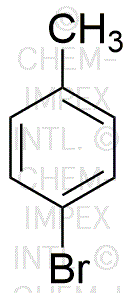4-Bromotoluene is widely utilized in research focused on:
- Synthesis of Pharmaceuticals: It serves as an important intermediate in the production of various pharmaceutical compounds, enhancing the efficiency of drug development.
- Organic Synthesis: This chemical is used in the synthesis of other organic compounds, making it a valuable building block for chemists in both academic and industrial settings.
- Material Science: It is employed in the formulation of polymers and resins, contributing to the development of materials with specific properties like durability and heat resistance.
- Electronics: 4-Bromotoluene is utilized in the production of certain electronic components, where its chemical properties help improve performance and reliability.
- Research Applications: In laboratories, it is often used as a reagent in various chemical reactions, aiding researchers in exploring new chemical pathways and reactions.
General Information
Properties
Safety and Regulations
Applications
4-Bromotoluene is widely utilized in research focused on:
- Synthesis of Pharmaceuticals: It serves as an important intermediate in the production of various pharmaceutical compounds, enhancing the efficiency of drug development.
- Organic Synthesis: This chemical is used in the synthesis of other organic compounds, making it a valuable building block for chemists in both academic and industrial settings.
- Material Science: It is employed in the formulation of polymers and resins, contributing to the development of materials with specific properties like durability and heat resistance.
- Electronics: 4-Bromotoluene is utilized in the production of certain electronic components, where its chemical properties help improve performance and reliability.
- Research Applications: In laboratories, it is often used as a reagent in various chemical reactions, aiding researchers in exploring new chemical pathways and reactions.
Documents
Safety Data Sheets (SDS)
The SDS provides comprehensive safety information on handling, storage, and disposal of the product.
Product Specification (PS)
The PS provides a comprehensive breakdown of the product’s properties, including chemical composition, physical state, purity, and storage requirements. It also details acceptable quality ranges and the product's intended applications.
Certificates of Analysis (COA)
Search for Certificates of Analysis (COA) by entering the products Lot Number. Lot and Batch Numbers can be found on a product’s label following the words ‘Lot’ or ‘Batch’.
*Catalog Number
*Lot Number
Certificates Of Origin (COO)
This COO confirms the country where the product was manufactured, and also details the materials and components used in it and whether it is derived from natural, synthetic, or other specific sources. This certificate may be required for customs, trade, and regulatory compliance.
*Catalog Number
*Lot Number
Safety Data Sheets (SDS)
The SDS provides comprehensive safety information on handling, storage, and disposal of the product.
DownloadProduct Specification (PS)
The PS provides a comprehensive breakdown of the product’s properties, including chemical composition, physical state, purity, and storage requirements. It also details acceptable quality ranges and the product's intended applications.
DownloadCertificates of Analysis (COA)
Search for Certificates of Analysis (COA) by entering the products Lot Number. Lot and Batch Numbers can be found on a product’s label following the words ‘Lot’ or ‘Batch’.
*Catalog Number
*Lot Number
Certificates Of Origin (COO)
This COO confirms the country where the product was manufactured, and also details the materials and components used in it and whether it is derived from natural, synthetic, or other specific sources. This certificate may be required for customs, trade, and regulatory compliance.


